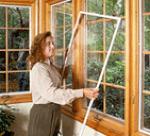Search engine visitors - click here to access entire "$ensible Home" web site
Click here to see a descriptive illustration showing diagrams and photos of several interior storm window kits.
Dear Jim: My windows are still in good shape, but it is chilly near them and the utility bills are high. Are rigid interior storm window kits very efficient and effective and can I really install them myself? - Mike R.

A: Reusable rigid interior storm windows make a big difference in how chilly you feel near a window. The actual savings on your utility bills will depend on the condition and efficiency of your existing windows. The reduction of outdoor noise coming through your windows will be surprising.
You should also notice reduced fading of your carpeting and curtains with these storm windows installed. With many kits, you purchase clear acrylic or other rigid plastic sheets at a home center store. Fade protection varies with different types and grades of plastic, so check the specifications.
Although there several simple attachment methods, kits with magnetic frames are one of the easiest to install yourself. Each fall, wipe off the dust and place them against adhesive-backed steel strips in the window opening. These steel strips are very narrow and barely noticeable.
If you air-condition your house during the summer, leave your storm windows up year-round. They are as effective at blocking heat from coming indoors as they are at blocking heat loss during the winter.
Much of the energy and utility bills savings come from the dead air space that is created between the storm and primary windows. A relatively narrow air space is often more effective than a very wide one. The remainder of the savings result from reduced air leakage past the primary window.
For most windows, any of the magnetic-type storm windows will attach quickly and seal air leaks well. For wavy or warped old windows, consider installing a kit that uses a magnetic flexible bellows seal. This is the type I use in my home under a large skylight with wavy rough-sawn wood trim.
These are designed similar to a refrigerator door seal, so they conform to uneven surfaces. Although clear acrylic is a fairly tough plastic, a crack can form from a strong impact. The magnetic flexible bellows will also absorb some of the shock from children's heads, kicking feet and flying toys.
Another attachment method for interior storm windows uses a stainless steel spring system. It pushes the seal outward against the inside of the window opening to hold the storm window in place. When you take them down, there is no narrow steel strip still in the window opening or on its frame.
Two other easy-to-install storm window kits use hook-and-loop and foam tube pipe attachment methods. The foam tube seals well on all types of windows.
Instant Download Update Bulletin No. 563 - buyer's guide of 10 interior storm windows and kits, frame materials (vinyl, PVC pipe/foam, aluminum, polypropylene), attachment methods (magnetic, clips, compression, hook and loop, plastic channel, steel spring system), glazing options (acrylic, plastic film, glass), frame colors, features, installation instructions for several different types of kits and specifications.
Dear Jim: I need to install some type of gas or wood space heater. I was at the home center store and I saw several types of vent pipe (B, DV and V). What are the differences among them? - Skip W.
A: Always check your local codes first for the approved type of vent pipe. B-vent is a double-walled, insulated aluminum vent pipe. It can be used for most gas appliances.
V-vent is the same, but the inner wall is made of stainless steel for burning wood. DV-vent is for direct venting. It is made of two concentric pipes to allow combustion air to come indoors and flue gases to exhaust outdoors.